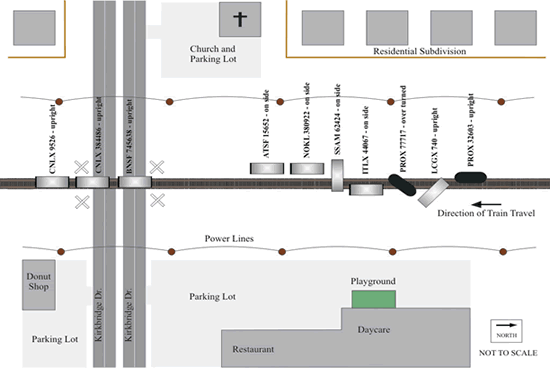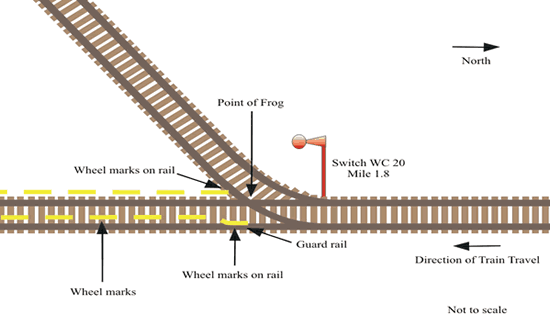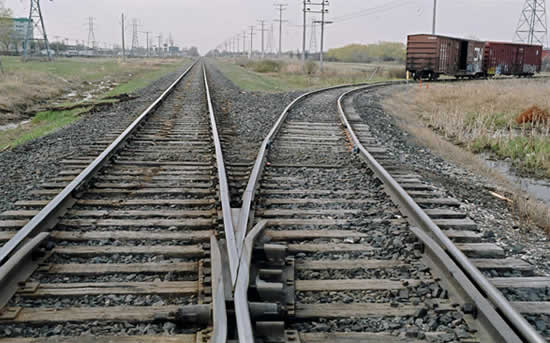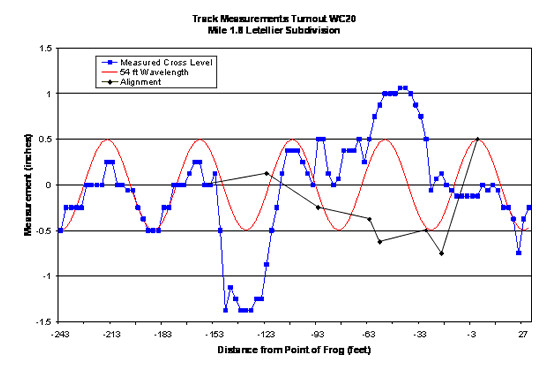Derailment
Canadian National
Train No. L53241 12
Mile 4.55, Letellier Subdivision
Winnipeg, Manitoba
The Transportation Safety Board of Canada (TSB) investigated this occurrence for the purpose of advancing transportation safety. It is not the function of the Board to assign fault or determine civil or criminal liability. This report is not created for use in the context of legal, disciplinary or other proceedings. See Ownership and use of content. Masculine pronouns and position titles may be used to signify all genders to comply with the Canadian Transportation Accident Investigation and Safety Board Act (S.C. 1989, c. 3).
Summary
On 12 January 2005, at approximately 1125 central standard time, southward Canadian National freight train L53241 12 derailed 10 cars at Mile 4.55 of the Letellier Subdivision in the city of Winnipeg. A tank car containing liquefied petroleum gas derailed, but remained upright and did not release product. Several homes and business were evacuated. Approximately 400 feet of track was damaged. There were no injuries.
Ce rapport est également disponible en français.
Factual information
On 12 January 2005, at approximately 1000 central standard timeFootnote 1, Canadian National (CN) freight train L53241 12 (the train) departed Symington Yard in the city of Winnipeg, Manitoba, destined for Emerson, Manitoba. The train comprised one locomotive, 30 loaded cars, 11 empty cars and 1 residue tank car. It weighed 4297 tons and was 2598 feet long. The two members of the train crew, a locomotive engineer and a conductor, were qualified for their respective positions, and met regulatory fitness and rest standards.
En route, the train did not experience any unusual operating conditions. The train was traveling at 21 mph, with the throttle in the No. 5 position, at Mile 1.8 of the Letellier Subdivision. This was the first location where signs of the derailment were subsequently found. At Mile 4.55, an undesired emergency brake application (UDE) occurred. The locomotive event recorder indicated that at the time of the UDE, the train was traveling at 20 mph.
The crew followed emergency procedures and determined that 10 cars (the 16th to the 25th from the head-end), including a tank car of liquefied petroleum gas, had derailed. As a precaution, several homes and businesses were evacuated.
At the time of the occurrence, the temperature was -10°C, with blowing and drifting snow.
Site inspection after derailment
The locomotive came to rest at Mile 4.64, with the derailed cars in various positions along the right-of-way. Figure 1 shows a schematic of the derailment. The 16th car (CNLX 9526), a loaded covered hopper car, remained upright with the L4 and R4 wheels derailed. Examination of the car determined that pieces of the L3 and R3 roller bearing adaptors had broken away and were missing. The missing pieces were not recovered.
The 17th and 18th cars, both loaded covered hopper cars, were blocking the public crossing at Kirkbridge Drive, Mile 4.45. The 23rd car (PROX 77717), a tank car containing liquid calcium chloride, a non-regulated product, had overturned. A minimal amount of product was lost. The 25th car (PROX 32603) a tank car containing liquefied petroleum gas (UN1075), remained upright with no product loss.
Marks were observed on top of the ties leading north from the derailed cars to turnout WC20 at Mile 1.8 (see Figure 2). On the east side of the turnout, marks were observed on top of the guard rail, 12 3/8 inches north of the point of frog. At the end of the guard rail, marks were also observed on the ties between the rails. On the west side of the turnout, there were marks on the ties and on the tie plates starting at the heel of the frog. These marks continued between the rails on the industrial lead track, over a joint bar and along the west side of the main track.
Mechanical information for covered hopper car (CNLX 9526)
CNLX 9526 was a loaded 100-ton covered hopper car. This car received a certified car inspection in Melville, Saskatchewan, on 10 January 2005, and in Symington Yard on 11 January 2005. Prior to departure on 12 January 2005, the train received a number 1 air brake test.
Following the derailment, a mechanical inspection was performed on CNLX 9526 by qualified CN inspectors in the presence of TSB investigators. The measurements taken on the trucks were found to be within acceptable limits. Light oxidation was observed on the fracture surfaces of the L3 and R3 roller bearing adaptors. These adaptors were sent to the TSB Engineering Laboratory for analysis. The analysis (TSB Report LP 010/2005) revealed that the adaptors had failed from overstress, with no evidence of fatigue or pre-existing defects.
Particulars of the track
The Letellier Subdivision is Class 2Footnote 2 track between Portage Junction (Mile 0.0) and Emerson, Manitoba (Mile 63.4). Train movements are governed by the Occupancy Control System, in accordance with Canadian Rail Operating Rules. The maximum operating speed for freight trains from Mile 0.0 to Mile 2.3 is 20 mph, and from Mile 2.3 to Mile 62.1 is 25 mph. At the time of the accident, there were typically two trains per day. In 2004, the line carried 4.35 million gross tons.
Throughout the subdivision, the track consisted of 100-pound jointed rail secured to softwood ties with two spikes per tie plate. The ties were box anchored every second or third tie. The ballast was a mixture of crushed rock and crushed washed stone.
The turnout at Mile 1.8 was a number 8 right-hand 100-pound turnout, with a spring frog and a standard height guard rail conforming to AREMAFootnote 3 specifications (see Photo 1). The spring frog was supported by a base plate fastened to the ties with standard spikes. The guard rail was bolted to the running rail and rested on plates fastened to the ties with standard spikes. A spring frog has a hinged wing on the diverging route that is held in place by a spring. This wing provides solid support for the wheel during a main track movement, but opens under lateral pressure for a diverging route movement.
Track geometry inspection requirements
Transport Canada's Track Safety Rules require that Class 2 track receive a minimum of two hi-rail inspections per week, provided that at least one geometry car inspection had been performed in the previous year. In addition, turnouts require a walking inspection once per month. A review of CN's records indicated that the frequency of inspections on the Letellier Subdivision met or exceeded the prescribed minimum.
CN's Standard Practice Circular 3101 categorizes track geometry defects into three threshold levels: priority, near urgent and urgent. Priority defects exceed CN allowable maintenance standards and must be monitored until repaired. Near urgent defects are approaching the urgent defect level and remedial action must be taken within 30 days. Urgent defects exceed the values permitted by Transport Canada and remedial action must be taken before the passage of the next train.
Cross-level defects in the track (e.g., warp 62) and their contributions to rock and roll harmonics are very difficult to detect through visual inspection. To determine the magnitude of warp 62, a cross-level deviation at one location must be compared against the maximum or minimum cross-level deviation within 62 feet. To determine if cross-level deviations will induce rock and roll harmonics, comparisons must be recorded for six consecutive pairs of joints. The only methods for detecting these defects are track geometry car inspection and manual measurement.
Track geometry inspections conducted on the Letellier Subdivision
The last track geometry car inspection conducted prior to the accident on the Letellier Subdivision was on 22 May 2004. A near urgent defect (warp 62) was found at Mile 1.72. CN provided records indicating that this near urgent defect had been corrected.
Another track inspection was conducted on 24 June 2004, using a specially equipped hi-rail truck that can measure and record track geometry defects. This specially equipped truck allows CN to augment track geometry car inspections and, in particular, to augment inspections in sidings and yard tracks that are rarely tested with track geometry cars. During the June 24 inspection, a near urgent defect (cross-level in tangent) was found at Mile 1.67.
A hi-rail inspection was performed on 11 January 2005, the day before the accident. No exceptions were noted in the vicinity of turnout WC20. A review of CN's inspection records for the two months prior to the accident revealed that no surface defects had been noted in the vicinity of the turnout. In addition, inspection records for the period between November 2004 and January 2005 indicated that both the surface and the alignment at turnout WC20 were in fair condition.
After the derailment on 12 January 2005, the gauge and guard check at the turnout were inspected and were found to be within standard. Track alignment measurements were also taken. Alignment was within prescribed standards. However, in the 21 feet prior to the point of frog, there was an alignment shift in the track from -¾ inch to +½ inch (i.e., track had shifted eastward).
Cross-level measurements were also taken starting from approximately 240 feet north of the turnout. Approximately 150 feet north of the point of frog, there was a near-urgent defect (warp 62). The cross-level deviations are plotted in Figure 3 and the values range from approximately +1 inch to -1 3/8 inches. In the plot, positive cross-level measurements identify locations where the west rail was high, while negative values identify locations where the west rail was low.
Conditions for car body oscillation
In Figure 3, a sine wave with a wavelength of 54 feet (i.e., the approximate spacing of track deviations) has been overlaid on the plot with the track measurements. The sine wave has been plotted to align as closely as possible to the maximum cross-level deviations.
A loaded 100-ton covered hopper car has a natural frequency of ½ to 2/3 cycles per second (cps).Footnote 4 A combination of car speed and consecutive track cross-level deviations can excite the car in this frequency range. This can lead to car body oscillation. Typically this occurs at speeds between 15 and 25 mph and can happen after as few as three deviations of ½ to ¾ of an inch. Severe car body oscillation can lead to wheel lift.Footnote 5
Prior derailment at turnout WC20
On 03 January 2005, nine days before the accident, a CN train heading south on the Letellier Subdivision derailed a car at turnout WC20. Wheel marks found in the snow by a CN loader operator indicated that the car derailed at the frog and subsequently re-railed at the crossing at Mile 4.13. Visual track inspections and measurements at the point of frog taken shortly after this derailment were unable to detect any defects in the track. No additional inspections were conducted and no corrective action was taken.
Analysis
The analysis will focus on the combined effects of car type, operating speed and track geometry with respect to rail car performance in the vicinity of turnout WC20.
The derailment
The wheel marks on top of the east guard rail at turnout WC20 were the first signs of the derailment. The position of these marks indicated that wheel lift had occurred before the wheels reached the point of frog. CNLX 9526 was the first derailed car. The wheel marks indicated that CNLX 9526 had travelled in a derailed state for approximately 2.75 miles before the train UDE occurred.
In the 240 feet north of turnout WC20, there were a number of cross-level deviations. Two of these cross-level deviations exceeded the priority level threshold, and there was one near urgent warp 62 defect. The spacing of these cross-level defects had a wavelength of approximately 54 feet. The train was traveling at 21 mph as it approached the turnout. The combination of train speed (i.e., within critical speed range of 15 to 25 mph) and the spacing of the cross-level deviations (i.e., wavelength of 54 feet) would have excited the covered hopper car CNLX 9526 of roughly 0.6 cps, which is within the ½ to 2/3 cps range of the natural frequency for this type of car. With the car operating in this critical frequency range, the resulting car body oscillation was sufficient to initiate wheel lift of the east wheels on the trailing truck. With this wheel lift, the guard rail could not perform its function of steering the west wheels past the point of frog. In addition, in the 21 feet just prior to the point of frog, there was a slight alignment shift eastward in the track. Therefore, as the trailing truck of CNLX 9526 approached the point of frog, the car would have resisted the small change in alignment, creating a lateral force on the rail. This lateral force was sufficient to open the spring wing in the turnout, resulting in the west wheels following the diverging route at the point of frog, and subsequently resulting in the derailment.
Track geometry car inspection frequency
In the course of normal track inspections, in the weeks prior to the two derailments in January 2005, no track surface defects were noted in the vicinity of turnout WC20. However, track measurements taken after the derailment indicated that there was a near urgent warp defect present in the vicinity of the turnout. Given that the road bed was frozen in January 2005, this near urgent warp defect had likely been present in the track at the time of the first derailment. Identification of this near urgent warp defect prior to the derailment would have precipitated corrective action to reduce the magnitude of cross-level deviations at the turnout. With this corrective action, there would have been a reduction in the severity of car body oscillation for CNLX 9526, likely preventing the wheel lift.
Because track defects (e.g., warp) can only be reliably detected through automated track geometry car inspection, or through detailed manual measurements, the frequency of track geometry car inspection is an important consideration for any track inspection program. On the Letellier Subdivision, the track inspection frequency met or exceeded the minimum standards specified in Transport Canada's Track Safety Rules (TSR).
However, despite meeting TSR quirements, urgent defects can appear and remain undetected in track until the next automated track geometry inspection. The greater the interval between track geometry car inspections, the longer urgent defects can potentially remain undetected.
Broken roller bearing adaptors
CNLX 9526 received several inspections from the time it was loaded until it left Symington Yard. During these inspections, there was no indication of problems with the roller bearing adaptors on car CNLX 9526.
Based on the test results from the TSB's Engineering Laboratory, the L3 and R3 roller bearing adaptors on car CNLX 9526 likely failed due to excessive forces during the derailment sequence.
Findings
Findings as to causes and contributing factors
- A number of consecutive cross-level deviations at a critical spacing in the track combined with car CNLX 9526 operating within a critical speed range, led to the wheel lift of the east wheels of this car.
- The slight alignment shift in the track in the vicinity of turnout WC20 created sufficient lateral force to open the spring wing, allowing the west wheels to follow the diverging route at the point of frog, resulting in the derailment of the train.
Finding as to risk
- Warp defects and rock and roll harmonics cannot be easily determined by visual track inspection. The longer the interval between geometry car inspections, the longer these conditions may go undetected.
Other findings
- The roller bearing adaptors on CNLX 9526 likely failed due to excessive forces generated during the derailment sequence.
Safety action
CN advised of the following safety action taken as a result of the derailment:
- The warp defect was immediately corrected by shimming.
- The track was machine surfaced and lined as soon as the ground was thawed.
- Due to the relative instability of the ground in the vicinity of the WC20 switch, the frog was changed to a standard non-spring frog.
- An education blitz was undertaken to teach track inspectors the importance of warp defects, and how best to locate them.
- A revised schedule has been put in place to make better and more frequent use of the Track Geometry hi-rail truck on branch lines.
This report concludes the Transportation Safety Board's investigation into this occurrence. Consequently, the Board authorized the release of this report on .



